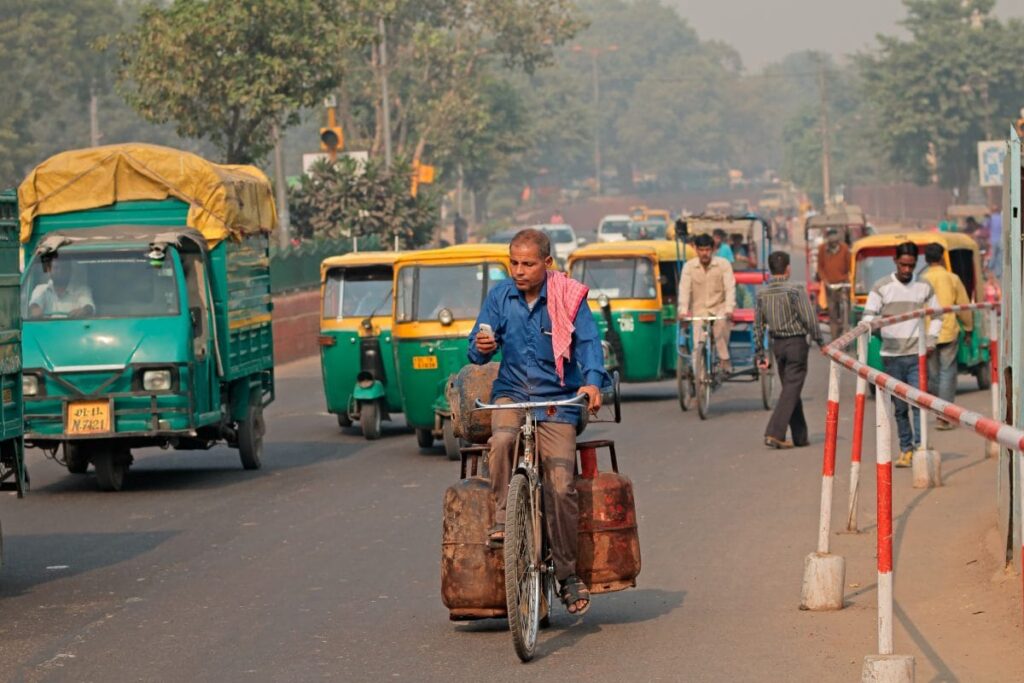
For a crisis of such a magnitude as COVID-19, it seems arguably grotesque to seek out a silver lining. However, it is undeniable that India’s lockdowns in response to the pandemic had a positive impact when it came to air pollution. Five cities with ordinarily high rates of pollution showed a temporary reduction in particulate matter smaller than 2.5 micrometers (PM2.5) of up to 54 percent.
The reduction in PM2.5, linked to the ‘anthropogenic emissions switch-off’ that occurred following the COVID-19 lockdown, was observed in a study published in November of last year by Sustainable Cities and Society. The research studied pollution levels between March and May of 2020 across five cities in India. These included Chennai, Delhi, Hyderabad, Kolkata, and Mumbai.
Emissions switch-off in India’s cities
India regularly dominates global rankings of the most-polluted cities; last year, data compiled in IQAir AirVisual’s 2019 World Air Quality Report identified India as being home to 21 of the world’s thirty most-polluted cities. Six Indian cities found themselves in the top ten. In the case of Delhi, pollution crises in the national capital have led to it being referred to as a ‘gas chamber’ more than once.
COVID-19 lockdowns had more than their fair share of detriments, but the resultant ‘anthropogenic emissions switch-off’ did carry benefits where air quality was concerned. Reductions in concentrations of harmful particles were found across all five cities studied over the duration of the study when compared to similar periods from the preceding five years.
Of the five cities involved in the study, Delhi showed the greatest reduction with PM2.5 decreasing by 54 percent. Across the other cities, there was a 32 percent reduction in PM2.5 in Chennai, 26 percent in Hyderabad, and 24 percent in Kolkata.
Large and densely populated cities with high traffic volumes seemed to correlate with high PM2.5 reductions, and as a result, a decrease in traffic correlated to a linear improvement in air pollution. The other major contributing pollutants came from commercial and industrial sectors where biomass burning, thermal power plants, and secondary particle formation as a result of demand for power all played a part.
As a whole, these pollutants were all impacted by the influences of lockdown strictness and duration, and meteorological fluctuations. Speaking about the impact of the pollutants and how to control them, Professor Prashant Kumar, co-author in the study, said “there are a number of ways to control emissions, either through active methods (controlling the sources, e.g. improving engine technologies, fuels, catalysts, etc.) or passive methods (alternative ways to reduce exposure, e.g. green barriers, etc.), which have been highlighted by researchers across the globe.”
Identification of economic and health benefits
This is far from a panacea, however. Despite the reduction in its PM2.5, Delhi’s hazardous air pollution rate is reported to have caused over 50,000 related deaths last year, and air pollution levels in the capital still remain almost six times above the prescribed World Health Organization (WHO) limits of 10 g/m3 annual mean. Yet there are still considerable benefits to be assessed from the reduction in PM2.5.
For one thing, the results offer promising insight for a country that is facing up to the long-term economic impacts of air pollution, as previously reported by Health Issues India. Results from the study showed that India could have saved as much as US$690 million in healthcare costs as a result of the reduction in PM2.5 concentrations.
Alongside this, the health benefits show that India avoided a possible 630 premature deaths. The research into COVID-19 lockdowns’ impact on air pollutants in Indian cities comes shortly after findings were published in Hypertension detailing the implications of particulate matter. It found that concentrations of fine particulate matter smaller than 2.5 microns could be traced to increased cardiovascular risk, partly through effects on blood pressure. Much of this pollution is emitted from automobile fumes, power generation, and other fossil fuels.
Speaking about how environmental and healthcare issues are shown to be interlinked, Kumar said, “air pollution in countries such as India remains important issues and concentrations are reaching alarming levels that consistently exceed ambient air quality standards. This situation enhances respiratory and cardiovascular diseases among the vulnerable public, which is evidence of the interlinkage between climate and healthcare.”
Future action on air pollution
The findings on particulate matter concentration serve to open up space for discussion about the possibilities of tackling air pollution, and environmental goals more broadly. Given that COVID-19 enforced lockdowns demonstrated the capabilities of entire countries to adjust to tackle global challenges, questions are raised about how similar collective efforts could work to create a sustainable ‘new normal’, and a framework that addresses climate change goals.
Speaking about the learnings of the observational opportunity arising out of COVID-19, Kumar said, “findings are counted as crystal-clear pieces of evidence to further confirm the message by environmentalism. The reduced levels of air pollution during lockdowns indicate clear health benefits, where policymakers should adopt and plan more rigorous strategies to control air pollution.”
Whilst the study can act as a proxy for upcoming policy decisions on pollution and climate and provide a thorough insight into the benefits lockdown had on particulate matter concentration, rigorous changes considered beneficial to the environment must be mindful of the potential negative economic consequences that may follow. Therefore, environmental changes should be planned, and proposed goals should be achieved steadily.

